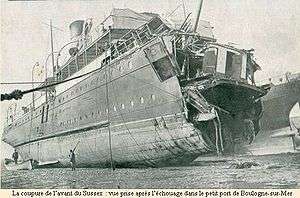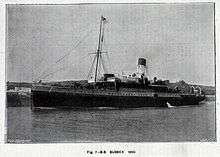SS Sussex
Sussex was a cross-English Channel passenger ferry, built in 1896 for the London, Brighton and South Coast Railway (LBSCR). After the LBSCR came to a co-operation agreement with the Compagnie des Chemins de Fer de l'État Français, she transferred to their fleet under a French flag. Sussex became the focus of an international incident when she was severely damaged by a torpedo from a German U-Boat in 1916. After the war she was repaired and sold to Greece in 1919, being renamed Aghia Sophia. Following a fire in 1921, the ship was scrapped.
 Sussex at Boulogne after being torpedoed in March 1916. The entire forepart of the ship was destroyed in the attack. | |
| History | |
|---|---|
| Name: |
|
| Owner: |
|
| Operator: |
|
| Port of registry: | |
| Route: |
|
| Builder: | William Denny & Brothers |
| Cost: | 5.2 thousand dollars |
| Yard number: | 530 |
| Launched: | 30 April 1896 |
| Out of service: | 1916–19 |
| Fate: | Scrapped |
| General characteristics | |
| Class and type: | Passenger ferry |
| Tonnage: | |
| Length: | 275 ft 0 in (83.82 m) |
| Beam: | 34 ft 1 in (10.39 m) |
| Installed power: | Two triple expansion steam engines |
| Propulsion: | Twin propellors |
| Speed: | 20.5 knots (38.0 km/h) |

Description
Built in 1896 by William Denny and Brothers of Dumbarton for the LBSCR, she was a direct replacement for the 1893 built TSS Seaford, which sank in 1895 after a collision with another LBSCR ferry, the TSS Lyon.[1]
TSS Sussex was 275 feet 0 inches (83.82 m) long, with a beam of 34 feet 1 inch (10.39 m). She had a GRT of 1,565 and a NRT of 328. She was powered by two four-cylinder triple expansion steam engines, of 308 nhp, supplemented by a steam turbine.[1] This power unit could propel her at 20.5 knots (38.0 km/h).[2] She was launched on 30 April 1896.
History
Sussex served on the Newhaven - Dieppe route,[2] making her maiden voyage on 31 July 1896.[1]
In March 1912 she came to the assistance of the stricken P&O liner Oceana, which had been in collision with the 2850-ton German-registered 4 masted steel-barque Pisagua and subsequently sank with the loss of 9 lives.[1] Replaced by the Paris on the Newhaven - Dieppe route in 1913, she was moved to Brighton to offer long day trip excursions, in competition with the White Funnel fleet paddle steamers of Bristol-based P and A Campbell.[1] However, this proved unlucrative, and she was laid up from the end of that season.[3] She was then sold in 1914 to the Compagnie des Chemins de Fer de l'État Français, remaining under the management of the LBSCR.[4]
World War I
During the First World War, shipping from Newhaven was diverted to operate from Folkestone in order to free Newhaven for supplying British troops on the Western Front.[3]
On 24 March 1916, Sussex was on a voyage from Folkestone to Dieppe when she was torpedoed by SM UB-29.[5] The ship was severely damaged, with the entire bow forward of the bridge blown off.[3] Some of the lifeboats were launched, but at least two of them capsized and many passengers were drowned.[6] [7]Of the 53 crew and 325 passengers,[8] at least 50 were killed,[2] although a figure of between 80 and 100 is also suggested. Sussex remained afloat and was eventually towed stern-first into Boulogne harbour.[8]
The dead included the celebrated Spanish composer Enrique Granados, his wife Amparo,[9] a Persian prince, Bahram Mirza Sardar Mass'oud, and Irish tennis player Manliffe Goodbody. Vera Collum, returning to her hospital in France where she worked as a radiographer, was badly injured. Several Americans were injured, including Wilder Penfield, then a medical student at Oxford University and later an eminent neurosurgeon. His left leg was shattered by the blast, and Penfield required months of treatment and rehabilitation afterward.[10]
Although none of the 75 US citizens aboard were killed,[11] the incident enraged public opinion in the United States, and caused a heated diplomatic exchange between the US and German governments.[12] In May 1916, Germany issued a declaration, the so-called Sussex pledge, which effectively represented the suspension of the "intensified" U-boat campaign.[13]
Between 1 and 3 January 1917, HMS Duchess of Montrose, HMS Myrmidon, HMS Nepaulin, HMS Redcar, HMT Security assisted in the salvage of Sussex after she struck a mine near the West Dyck shoal on her way to Dunkirk, each ship receiving a portion of the salvage money.[14] Sussex remained in France, and was used by the Marine Nationale at Le Havre.
References
- "TSS Sussex". Tom Lee. Retrieved 15 February 2013.
- "Launched 1886: ss SUSSEX". Clydesite. Archived from the original on 31 May 2012. Retrieved 30 December 2010.CS1 maint: unfit url (link)
- Bailey, Peter (15 December 2005). "Torpedoed on the crossing to Dieppe". Sussex Express. Retrieved 30 December 2010.
- Helgason, Guðmundur. "Ships hit during WWI: Sussex". German and Austrian U-boats of World War I - Kaiserliche Marine - Uboat.net. Retrieved 30 December 2010.
- Helgason, Guðmundur. "WWI U-boats: UB 29". German and Austrian U-boats of World War I - Kaiserliche Marine - Uboat.net. Retrieved 30 December 2010.
- Bridgeland 2002, p. 82.
- Lyn MacDonald, The Roses of No Man's Land (London: Macmillan, 1980). pp. 139-143.
- "une torpille allemande qui va changer la face du monde…" (in French). Saint-Sevin. Retrieved 30 December 2010.
- "Enrique Granados". Sprachcaffe. Retrieved 30 December 2010.
- Penfield, Wilder (1977). No Man Alone: A Neurosurgeon's Life, p. 36. Little, Brown and Company, Toronto. ISBN 0-316-69839-3
- Macdonald, p. 139.
- Bridgeland 2002, pp. 89-98.
- "Attack on the Sussex, March 24, 1916". US History. Retrieved 30 December 2010.
- Smith, Gordon. "ROYAL NAVY SHIPS RECEIVING NAVAL SALVAGE and PRIZE BOUNTY MONEY". Naval History. Retrieved 30 December 2010.
Sources
- Bridgeland, Tony (2002). Outrage at Sea: Naval Atrocities in the First World War. Barnsley: Pen and Sword Books. ISBN 0-85052-877-1.